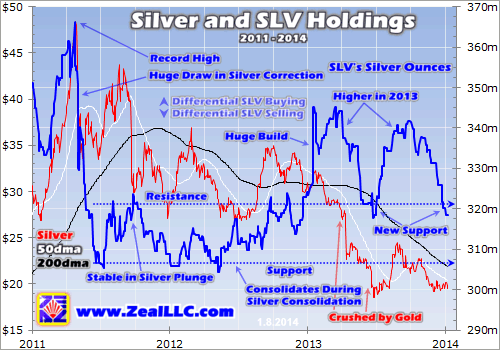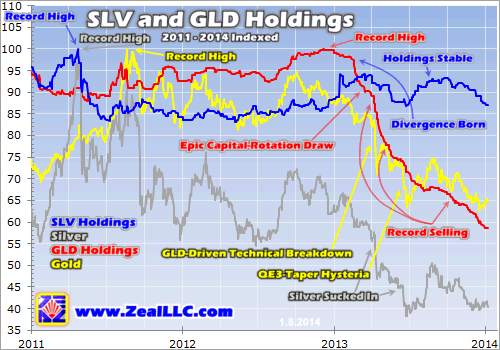By Adam Hamilton
Despite its miserable 2013, latent investor interest in silver remains strong. This manifested in robust worldwide demand for physical silver driven by its lower prices. The hidden strength in silver was also evident in the holdings of its flagship ETF, which held steady in defiance of plummeting silver prices. SLV’s massive bullish divergence reveals big dormant silver investment demand ready to be unleashed.
If there was ever a year to scare investors away from silver, 2013 was it. This white metal plummeted 35.6% last year, its worst calendar-year performance in 32 years! As the general stock markets melted up in response to the Fed’s epic money printing, capital fled alternative investments like precious metals so their prices utterly collapsed. Silver was largely left for dead, with only hardened contrarians remaining.
Investors have always chased performance, loving to crowd into overpriced assets that have already rallied sharply. That perfectly summarizes 2013’s astounding general-stock-market surge. The corollary to this is investors loathe underperformance and quickly bolt from it. With silver underperforming the benchmark S&P 500 stock index by a brutal 65% last year, there should truly be no silver investors left.
Yet the very stock investors who chose to own silver in the form of the dominant SLV silver ETF didn’t abandon it. The silver bullion held in trust for the shareholders of the SLV iShares Silver Trust merely retreated by 1.3% last year! This is nigh on miraculous when you think about it. The investors with the easiest way to shift capital away from silver exposure largely chose to hold on to this plummeting metal.
If someone had forecast a year ago that SLV’s holdings would only slip 1.3% while silver suffered a 35.6% plunge that was its worst year in several decades, they would have been laughed out of the markets. That notion is ludicrous. The worst year ever for SLV’s holdings was 2011 when they dropped 12.0% in response to just a 10.2% silver selloff. Last year’s SLV bullish divergence was truly extraordinary.
Launched in April 2006, SLV is a tracking ETF designed to mirror the price of silver. This mission can only be accomplished if the supply-demand differentials between SLV shares and silver itself can be equalized. SLV can’t work unless stock-market capital can use it as a conduit to flow into and out of physical silver bullion. SLV’s price would quickly decouple from silver if these flows were impeded.
When stock investors buy SLV at a faster pace than silver is being bought, SLV’s price rises faster than silver’s. If this continued SLV would fail its tracking mission. So its custodians issue new shares in order to expand supply to meet the high demand. They use the proceeds from these sales to buy more silver bullion, growing SLV’s holdings. This process shunts stock-market capital directly into silver.
But SLV also faces differential selling pressure when SLV shares are sold at a faster pace than silver is. SLV’s price drops faster than silver’s, threatening to decouple to the downside. SLV’s custodians have to act to sop up this excess supply, so they buy back SLV shares themselves. They raise the capital to do this by selling some of SLV’s silver bullion. So stock-market capital flows out of silver via the SLV ETF.
Given silver’s dreadful price action last year, SLV shareholders should have been rushing for the exits. SLV should have faced unprecedented differential selling pressure like its big brother GLD, the flagship gold ETF. Instead SLV’s holdings unbelievably held strong. This first chart looks at them superimposed over the silver price in recent years. The implications of this massive SLV divergence are super-bullish.

SLV’s custodians publish this ETF’s total silver holdings daily. Charted over time, they offer a priceless barometer of how stock traders feel about silver. When they get bullish on it, they aggressively buy SLV shares and capital floods in from this differential buying pressure. The opposite happens when they wax bearish on silver, capital flees and SLV’s holdings drop on heavy differential selling pressure.
But the latter didn’t happen last year. To get some crucial context, let’s start at the parallel record highs in silver and SLV’s holdings back in April 2011. Silver has always been an exceedingly-volatile speculators’ playground. When silver is soaring, its allure is overpowering. And as such a tiny market in the grand scheme, it doesn’t take much external capital to catapult silver higher. Like back in early 2011.
By late April that year, silver had skyrocketed 57.1% higher year-to-date! As I warned leading into those parabolic highs, silver was euphoric and wildly overbought. But its incredible strength was mainstream financial news that enticed in plenty of stock-market capital. The resulting differential buying pressure in SLV pushed its holdings up to their all-time record high of 366.2m ounces near the end of that month.
But silver needed to correct after running so far so fast to such lofty heights, and it promptly did in one of its infamous near-crashes. In less than 2 months silver plummeted 30.8%, scaring stock traders into panic. They fled SLV faster than silver itself was being sold, driving SLV’s holdings down 16.6% in a similar short timeframe. That post-parabolic-high SLV-holdings low of 305.5m ounces is very important.
It formed SLV-holdings support which held throughout silver’s high consolidation in the rest of 2011 and 2012 before 2013’s crazy selling anomaly arrived. Even as silver slumped to new correction lows in late 2011 and mid-2012, SLV’s holdings never materially breached that 307m-ounce support level. Stock traders were holding onto their SLV shares despite silver’s long correction, even before 2013’s anomaly.
Provocatively leading into last year, SLV’s holdings were breaking out above their consolidation resistance line near 321m ounces. Stock traders were selling their SLV shares slower than silver was being sold, forcing this ETF’s custodians to issue shares to maintain tracking. This kept SLV’s price in line with silver’s selloff, and the capital SLV raised was shunted into silver bullion. Stock investors were holding.
So at the end of 2012, SLV’s holdings of 324.2m ounces were at their highest level since late in silver’s massive post-parabola correction in mid-2011. Then in mid-January 2013, SLV’s holdings soared by 18.4m ounces in a single trading day on enormous differential buying pressure! That buy was worth $579m at prevailing silver prices then, so it had to be a hedge fund. Such huge builds are very rare.
After SLV’s birth month when it was exploding from nothing, single-day 5%+ holdings builds have been exceedingly rare. As of this week, there have only been 4 in 1917 trading days! And this last one nearly a year ago pushed SLV’s holdings back up to 345.1m ounces. Propelled way above their multi-year silver-consolidation resistance, this big SLV buy provided a buffer to absorb much of the coming selling.
Thus SLV experienced enough differential buying pressure in 2013’s first quarter to drive its holdings up 6.1% even though the silver price slid 6.5% lower. The second quarter was radically worse, when gold’s epic selloff sparked by a technical breakdown and QE3-tapering hysteria blasted silver down a brutal 30.7%. Yet SLV’s holdings held relatively strong, merely retreating 7.5% in that horrendous quarter.
Stock investors certainly weren’t buying SLV on balance with silver free-falling, but they weren’t selling this ETF much faster than silver was being sold. So the overall draw on SLV’s bullion was far milder than you’d expect given its historical interaction with silver selloffs. To cement how extraordinary SLV holdings’ resilience was in that carnage, the GLD gold ETF’s holdings plummeted 20.6% that quarter!
Then in the third quarter silver enjoyed a rather modest rally by its own wild standards, climbing 10.6%. Yet SLV’s holdings quickly shot up on this silver strength, rising 7.3% in that period. Provocatively the lion’s share of this buying came in July before silver really started rallying! SLV’s holdings surged 5.2% that month even though silver only rallied 1.1%. Stock investors remained very interested in silver.
Gold is silver’s primary driver, responsible for over 92% of silver’s daily price action in its entire secular bull as I explained a few weeks ago. Gold had just suffered its worst calendar quarter in 93 years, since 1920! Silver’s was likely similarly extreme. Yet even in the midst of this once-in-a-lifetime slaughter in precious metals, stock traders were still ready to flood back into SLV at the merest hints of life in silver.
Gold dragged down silver again in the fourth quarter, it fell 10.1%. And while SLV suffered differential selling pressure in this hyper-bearish environment, its holdings only dropped 6.3%. That was far better performance than the 11.9% fall in GLD’s holdings in that timeframe, and left SLV’s holdings only down slightly in 2013. The magnitude of this anomaly is stunning, and better appreciated in broader context.
This next chart looks at SLV’s holdings, silver, GLD’s holdings, and gold indexed off their respective record highs in recent years. Each individual record is assigned a value of 100, with all the subsequent percentage price action keyed off that. The result is perfectly-comparable indexed data that shows how extraordinary SLV’s bullish divergence was last year. The fact that it actually happened is still shocking.

Before 2013 dawned, the precious-metals markets were normal. Both gold and silver were consolidating high after major uplegs in 2011, and the holdings of their flagship ETFs were stable near record highs. Precious metals were considered an essential asset class for portfolio diversification, as they have been throughout all of history. Gold and silver entered 2013 near $1675 and $30, close to 18-month averages.
But then a perfect storm hit. The US stock markets started levitating right out of the gates, climbing to marginal new high after marginal new high. This was because Ben Bernanke’s Federal Reserve was working overtime to convince stock traders that it would accelerate its unprecedented money printing if necessary to stave off any economic weakness. Stock traders figured this put a floor under stock prices.
So they gradually forgot about diversification and started shifting all their eggs into one basket. They sold alternative investments including gold, which manifested in extreme differential selling pressure in the GLD gold ETF. In indexed terms above, this record mass exodus from GLD is breathtaking! Since GLD’s shares were being sold faster than gold, its custodians had to sell bullion to sop up that excess supply.
This new gold supply coming from GLD liquidations alone was greater than global demand growth so gold’s price started falling. With US stock markets still melting up and seducing capital away, this dynamic started to feed on itself. The farther gold sold off, the less stock investors wanted anything to do with it through GLD. The more GLD shares they sold, the farther gold fell. It was a maddening vicious circle.
As GLD was abandoned and gold plummeted, silver was dragged down with it. But surprisingly silver itself showed plenty of relative strength. Its price only leveraged gold’s decline last year by 1.27x. This leverage to gold has often exceeded 2 to 1 in past major gold corrections, so silver was far more resilient than it had any right to be. And one big reason was that SLV wasn’t forced to hemorrhage its holdings.
The divergence between the SLV line above and everything else is massive. In the midst of the worst precious-metals environment in nearly a century, American stock investors chose to largely hold on to their SLV shares. And they were quick to buy more within days after silver started bouncing mid-year. This reveals great latent interest for silver investment even among stock investors, which is amazing [...]
Original source: Zealllc
Reproduction, in whole or in part, is authorized as long as it includes all the text hyperlinks and a link back to the original source.
The information contained in this article is for information purposes only and does not constitute investment advice or a recommendation to buy or sell.

















